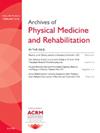Functional MRI Evaluation of Hyperbaric Oxygen Therapy Effect on Hand Motor Recovery in a Chronic Poststroke Patient 4356
IF 3.6
2区 医学
Q1 REHABILITATION
Archives of physical medicine and rehabilitation
Pub Date : 2025-04-01
DOI:10.1016/j.apmr.2025.01.060
引用次数: 0
Abstract
Objectives
To investigate neural mechanisms and reorganization underlying hyperbaric oxygen therapy in a patient with chronic stroke.
Design
Study included a 61-year-old right-handed male who suffered hemiparesis and physical weakness in the right upper limb, 2 years after acute insult treated with 60 daily HBOT sessions. Motor task fMRI activation and resting-state functional connectivity (rsFC), Fugl–Meyer assessment (FMA) and handgrip maximum voluntary contraction (MVC) were assessed at baseline and the end. Results were compared with a matched healthy control subject.
Setting
Study was conducted within a hospital-based research facility using a multiplace Starmed-2700 chamber to administer HBOT protocol.
Participants
One 61-year-old right-handed man with right hemiparesis, speech, and cognitive impairments due to left frontal chronic ischemic stroke. One 64-year-old, right-handed man without history of neurologic impairments or upper-limb movement limitations participated. Participants signed written informed consent.
Interventions
HBOT protocol comprised of 60 daily sessions, 5 per week over 2 months. Protocol included breathing 100% oxygen by mask at 2ATA for 90-min with 5-min air breaks every 20-min. Compression/decompression rates were 1.0 m/min. Patient received physical and occupational therapy twice a week during therapeutic phase. The physical therapy focused on lower limb mobility, transitions between body positions, enhancing walking pace with and without a cane, proprioceptive training to augment coordination, reflexes, and balance. Occupational therapy incorporated activities of daily living (ADLs).
Main Outcome Measures
Primary study outcome was functional activation changes using motor task fMRI.
Results
After HBOT, the FMA score improved from 17 (severe) to 31 (moderate). After the intervention during trials involving the affected hand, there was an observed increase in fMRI activation in both the supplementary motor cortex (SMA) and the premotor cortex (PMA) bilaterally. The lateralization index (LI) decreased from 1 to 0.63, demonstrating the recruitment of the contralesional hemisphere. The region of interest, ROI-to-ROI, analysis revealed increased postintervention interhemispheric connectivity (P=.002) and a between-network connectivity increase (z-score, 0.35±0.21 to 0.41±0.21; P<.0001). Seed-to-voxel-based rsFC analysis using the right SMA as seed showed increased connectivity to the left posterior parietal cortex, the left primary somatosensory cortex, and the premotor cortex.
Conclusions
Study provides additional insights into HBOT-induced brain plasticity and functional improvement in patients with chronic poststroke.
Disclosures
AH, VE, and SE work for AVIV Scientific Ltd. SE is a shareholder at AVIV Scientific Ltd. The remaining authors declare that the research was conducted in the absence of any commercial or financial relationships that could be construed as a potential conflict of interest.
求助全文
约1分钟内获得全文
求助全文
来源期刊
CiteScore
6.20
自引率
4.70%
发文量
495
审稿时长
38 days
期刊介绍:
The Archives of Physical Medicine and Rehabilitation publishes original, peer-reviewed research and clinical reports on important trends and developments in physical medicine and rehabilitation and related fields. This international journal brings researchers and clinicians authoritative information on the therapeutic utilization of physical, behavioral and pharmaceutical agents in providing comprehensive care for individuals with chronic illness and disabilities.
Archives began publication in 1920, publishes monthly, and is the official journal of the American Congress of Rehabilitation Medicine. Its papers are cited more often than any other rehabilitation journal.

 求助内容:
求助内容: 应助结果提醒方式:
应助结果提醒方式:


